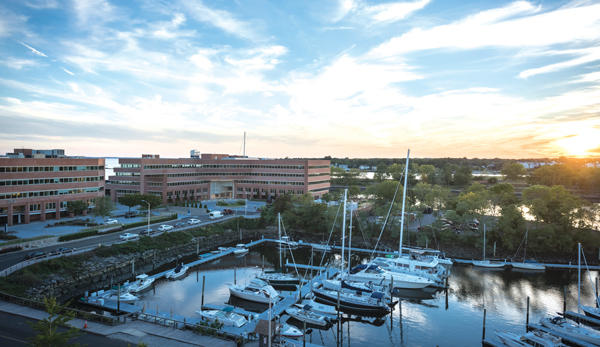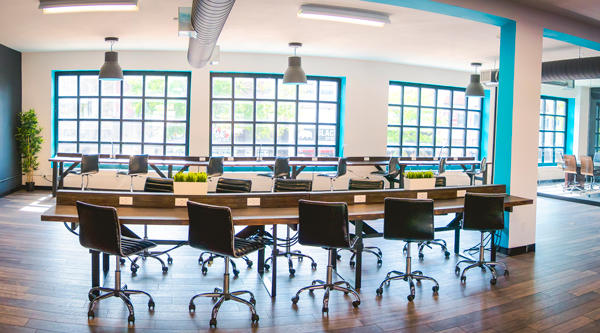Trending
Co-working sprouts in suburbia
Shared office spaces are courting a variety of tenants as they expand outside Manhattan

When Jonathan Manierre and Ryan Doran decided they needed new digs for their growing ad and marketing agency, Turkois, the design duo contacted realtors and did a traditional office search. In the end, they settled on 2,500 square feet of storage space over a restaurant in White Plains, New York, and prepared to rent out parts of the space under the name KOI Creative Space. The idea of a co-working space spoke to their mutual desire for community and collaboration.
Today, the Mamaroneck Avenue location, which debuted in 2016, is not only home to Turkois, but also 70 co-working members ranging from accountants and real estate agents to ride-sharing companies and corporate project teams. The venture has been so successful that Doran and Manierre are now working on a second co-working location down the block, bankrolled by the money they’ve made from KOI, where full-time membership is $405 per month.
“We’re meeting a need,” Manierre said. “We had heard of co-working and had been to WeWork and felt like Westchester was vastly underserved.”
As co-working giants like WeWork — now known as the We Company following a January rebranding — Knotel and Regus parent company IWG march into major cities around the globe, a clutch of boutiques, ambitious independents and some larger outfits are making a bet on markets surrounding New York City. Those mostly peripheral players are opening new sites and expanding their co-working footprint by attracting entrepreneurs, small businesses, corporate refugees and larger companies looking to cut costs and boost productivity.
“It’s a hot market,” said Donna Miller, founder and president of C3 Workplace, a co-working and shared office rental firm with two New Jersey locations, in Montclair and Sparta. “Today, there are four [co-working spaces] in Montclair. Three years ago, I was it.”
The growth in suburban co-working is a natural next step in the flexible space revolution that has overtaken the real estate industry ever since the We Company opened its first location in Manhattan’s Soho neighborhood in 2010. The amount of co-working space in Manhattan, the largest urban co-working market in the country, grew more than 47 percent between 2016 and 2018, according to commercial real estate firm Colliers International.
More broadly, at least 43.5 million square feet of commercial space were devoted to co-working in 20 major urban U.S. markets at the end of 2018, up 50 percent from a year earlier, according to real estate research firm Yardi Matrix.
Driving that trend is the increased diversity of co-working clients beyond startups and entrepreneurs, as big companies shun long-term leases in favor of arrangements that give them more flexibility and help them attract an increasingly mobile and millennial workforce. A CBRE analysis last year found that a vast majority of companies surveyed saw themselves using co-working space within the next three years.

Despite their growth, suburban co-working firms don’t have the supply of potential clients that their urban counterparts enjoy. At the end of 2018, urban markets accounted for 27.7 million square feet of co-working space, compared to 14.7 million in the suburbs, according to Yardi Matrix. That suburban number, however, does not account for smaller co-working spaces, which are common outside the city.
‘Selling community and inspiration’
In the tri-state suburbs, IWG’s Regus has long dominated the co-working industry, albeit an earlier iteration — the traditional shared office and office suite market. Regus operates 48 sites in Northern New Jersey, Long Island and Westchester and Fairfield counties. Another traditional player, Stark Office Suites, has five sites in Westchester. And Rye, New York-based Serendipity Labs, an up-and-coming co-working player with institutional backing, has other tri-state outposts in Ridgewood, New Jersey, Stamford, Connecticut, and, come April 1, White Plains, New York.
Other suburban entrants in the co-working space are mostly self-funded one- or two-site boutiques that market themselves as communities rather than office suite providers, although many offer private offices, as well as meeting and conference rooms.
Much of the suburban co-working environment also has a different vibe than its cosmopolitan counterpart. For starters, suburban spaces usually attract a slightly older cohort than those in the cities. At Serendipity Labs, the average age of members is 41, with 75 percent between the ages of 30 and 49.
“The use case for a suburban 40-year- old worker is they have a primary office somewhere else and use [co-working] to avoid the commute and make it to their kid’s recital,” said Serendipity Labs founder and CEO John Arenas, a former general manager and president of Americas franchising at Regus, who also founded Stratis Business Systems and Worktopia. “They’re using it for quality of life.”
And although many city co-working spaces tend to skew toward younger professionals or those looking for a primary office residence, those in the suburbs often sell to a different demographic and atmosphere. Meeting and event spaces for workshops, educational and networking discussions are key moneymakers and community builders. C3 Workspace, for one, not only provides such space, but also offers back-office support, virtual assistance, bookkeeping and business advisory services.
The Spur, a 150-member co-working community in the Hamptons that’s backed by local investors, makes a point of bringing weekenders together with the local business community. At Comradity in Stamford, de facto mentoring among members is common, said co-founder Katherine Kern. The space regularly hosts interns from local high schools and colleges.
 “We’re not selling space,” she said. “We’re selling community and inspiration.”
“We’re not selling space,” she said. “We’re selling community and inspiration.”
Like the partners behind KOI, Kern and her husband, Jim Kern, were looking for space for their consulting business in 2015 when they launched Comradity in 9,000 square feet of leased space above a barbecue restaurant. Comradity now has 100 members, including small companies and associations, lawyers and accountants, as well as such corporate clients as Con Edison, Danone and General Electric, which bought memberships for their employees to work remotely.
A runway for bigger tenants
Some suburban developers are also getting into co-working. George Comfort & Sons, landlord of Stamford’s Shippan Landing — a six-building, 780,000-square-foot office park on the Long Island Sound — in 2015 launched a co-working space called Workpoint equipped with televisions and post-production facilities for independent workers and small media companies. It now has 34 resident companies.
Dana Pike, a senior vice president at George Comfort, which acquired Shippan Landing in 2012, said that having tenants such as A&E Television Networks and the YES Network meant it made sense to have a co-working space catering to a specific industry.
“We wanted to create activity and also kind of a feeder system to grow the office component in the park,” Pike said. “A tenant could take two, three offices in a co-working facility and then graduate to become a bigger tenant.”
Gregory Dell’Aquila, president of Hoboken, New Jersey-based developer JDA Group, saw a similar opportunity. His 20,000-square-foot Mission 50 Workspaces, launched in 2011 and located in the penthouse of the Hoboken Business Center, has 50 regular members and hundreds of rotating tenants, he said, some of whom use the space for meetings. Dell’Aquila added that one former shared space member, a title company, has grown to 20 employees and 2,500 square feet in the building.
Creating a runway for businesses that might one day seek more office space could become a key component for co-working in the suburbs. Serendipity Labs now has 30 co-working sites around the country and commitments for more than 100 in the pipeline, including some franchised locations. Arenas, its founder, said he’s had conversations with landlords in Morristown, Short Hills and Summit in New Jersey, as well as others in Hicksville on Long Island and Westport, Connecticut.
“We see 20 [tri-state] locations… where we will settle in,” he said. “There’s a lot of room to grow.”

KOI Creative Space at 169 Mamaroneck Avenue in White Plains
IWG’s Regus also sees untapped potential in the region. Michael Berretta, vice president of network development for the Americas at IWG, said he’s seen a lot of interest from corporations. The company is looking at additional opportunities in “all major suburban cities and town centers” in the tri-state area, he said, some of which IWG could move into via its Spaces co-working brand.
“We look at every lease when it comes to maturity and make a strategic decision to rebrand, renovate or retrofit,” Berretta said.
Expansion plans
Whether other large co-working brands that have yet to venture beyond the city will take on the suburbs remains to be seen.
A spokesperson for the We Company — where shared workspace in New York City starts at $300 per month — said its primary focus is on building a presence in major cities around the world. Similarly, a Knotel spokesperson said its focus is on expanding in global gateway cities that serve as major commerce hubs. CBRE, which is poised to launch its own flexible space offering, called Hana, is also focused on the top 25 global markets, said Hana CEO Andrew Kupiec, who noted the suburbs “are certainly something we would consider in the future.”
George Comfort’s Pike, however, said he’s getting more phone calls from brokers advising co-working companies in urban areas that are now interested in taking space at suburban properties the company owns in the Philadelphia-to-Stamford corridor. Shlomo Silber, co-founder and CEO of Manhattan-based Bond Collective, a co-working firm that has embarked on a 30-location expansion across the U.S., said the suburbs could easily slide into the company’s expansion plans.
“It’s definitely something we would consider for the future,” Silber said. “Having some sort of smaller hub so that members who travel to the city during the week would have an opportunity to work locally, if needed.”
It’s unclear what an influx of co-working giants might mean for smaller players in the suburbs. Brand names bring the advantage of scale, which for one- and two-site outfits is hard to achieve. Jenifer Ross found that out the hard way. In 2011, she opened a co-working space called Watercooler in Tarrytown, New York, but shut it down in 2016.
“It’s tough to get economies of scale,” said Ross, who opened Watercooler with loan from a family member and now consults on coworking. “Unless you have a partner who owns the building, the rents are too expensive.”
KOI’s Manierre acknowledged that his co-working space needs to distinguish itself from larger suburban rivals like Regus, but he predicted that behemoths such as the We Company would have to scale down their business model to survive outside dense urban environments.
“I’m not really concerned,” Manierre said. “I feel like we found a market. People like to have a Manhattan vibe in the office, but they don’t want to pay $8 for a coffee.”
CORRECTION: 2/25/19, 11:42 a.m. EST. A previous version of this story misidentified a former job title for John Arenas at Regus.




